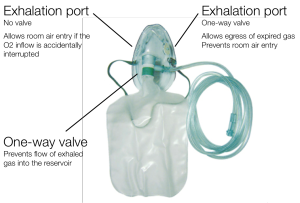As a prelude to a more detailed post on high flow (coming tomorrow) I thought that it would be a good idea to brush up on standard oxygen delivery devices and techniques – you know, the ones we use every day.
Blow-by
- Temporary O2 delivery
- Oxygen tubing, corrugated tubing, or simple mask held at a short distance from the child’s face
- Flow of at least 10L/min delivers <30% O2 Davies, Pediatrics, 2002
- Self-inflating (Ambu) ventilation bags should not be used to provide blow by oxygen since small patients can’t generate enough inspiratory force the overcome the one way valve. Flow-inflating (Mapleson) bags can be used however.
Nasal cannula
- Oxygen flowing into the nasopharynx mixes with room air
- paO2 varies by respiratory rate, tidal volume, oxygen flow rate, and mouth breathing
- Can give up to 100% O2 at a comfortable rate of 1 to 4 L/min
- >2L/min is very irritating unless heated/humidified
- The oxygen concentration that is delivered varies from 25-40% Bazuayae, Thorax 1992
- With flow >2 L/min you can actually generate unintended positive pressure Locke, 1992 Pediatrics
- In preemies mean pressure up to 9.8 cm H2O at higher flow rates
Face mask
- Flow rates between 6 and 10 L/min can provide 35-50% O2
- Depends on RR and fit
- >5 L/min prevents rebreathing of CO2 Myers Respir Care 2002 & Jensen 1991
Partial rebreather
- Simple mask with an attached reservoir
- 50-60% O2 with flow 10-12 L/min
- You adjust flow rate to keep reservoir from collapsing
- Patients get O2 from inflow and the reservoir bag
- Mostly used to conserve O2 reserves (such as in transport)
Non-rebreather
- Mask and reservoir system modified with two valves
- Limits mixing of exhaled gases and room air with the oxygen supply
- O2 up to 95% 10-15 L/min with a good seal Boumphrey, 2003 Resuscitation
- Adjust flow to prevent collapse of reservoir
Head hood
- Clear, plastic cylinders that encompass the infant’s head
- O2 80-90% percent @ flow of ≥10-15 L/min
- Air enters through an inlet and exits through neck opening
- Good if they can’t tolerate NC
- Too small for babies >1 year of age
Oxygen tent
- Clear, plastic shells that surround the child’s head and upper body
- Up to 50% O2 w/ high flow rates
- More RA mixing than hoods
- Not sufficient in practice if babies need >30% O2
- More limits to accessing the patient











